Persimmons
My fellow Sokcho blogger, gangwonbrian, has a nice little post about persimmons. It reminded me of my first encounter with persimmons, and better ecounters since.
In 1999, I was a brand-new teacher at a large (4000+ students) boarding school just
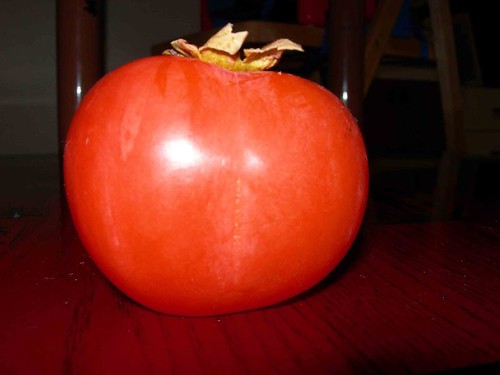 outside of Guangzhou, in SE China (our little town was actually ground zero for SARS, two years after I left). My grade 7 students had two weeks of mandatory “military” training at the beginning of the school year, and I was left with a lot of free time, so I thought I’d get my kitchen in order and invite my supervisor over for a western-style lunch. Once the date was set, I headed out to the market to see what was available. I decided to make spaghetti and tomato sauce. The tomatoes looked a little soft and had weird tops, but I assumed that they were just different, like all the other things I had encountered in my first few days in Asia.
outside of Guangzhou, in SE China (our little town was actually ground zero for SARS, two years after I left). My grade 7 students had two weeks of mandatory “military” training at the beginning of the school year, and I was left with a lot of free time, so I thought I’d get my kitchen in order and invite my supervisor over for a western-style lunch. Once the date was set, I headed out to the market to see what was available. I decided to make spaghetti and tomato sauce. The tomatoes looked a little soft and had weird tops, but I assumed that they were just different, like all the other things I had encountered in my first few days in Asia.It wasn’t until my meal preparation was in full swing that I realized something else different about these “tomatoes.” They had large, thin brown seeds inside, and weren’t as juicy as regular tomatoes. I went to work getting all the seeds out and threw them into my wok. It was once I started cooking that I realized that these were no close relative of the tomato, because my delicious tomato sauce quickly turned brown, and a taste test revealed that it was overpoweringly sweet. I had already wasted enough time with the seeds, there was no time to go back to the market, so I went on with whatever it was I was cooking. I tried to balance the sweetness with some vinegar, but even so, the result was a jam-like stew. Not having any alternative, and not knowing how to contact my supervisor to postpone the invitation, I cooked the spaghetti and served it, covered in brown persimmon jam.
My supervisor was very gracious, and ate two servings of the stuff. I explained that the dish hadn’t turned out anything like we normally eat in Canada, and that I had thought I was cooking with tomatoes. He pulled out his dictionary, and that’s when I learned what a persimmon is.
We became good friends over the course of the year, and it turned out he enjoyed cooking as much as I did. I learned how to cook several different kinds of simple Chinese food from him, and we did eventually have spaghetti, once I located the real tomatoes in the market.
Persimmons are a prominent part of Korean cuisine. In the fall, the leaves fall off the persimmon trees, leaving the bright orange fruit. A persimmon tree in the fall is a classic subject of Korean painting, and is one of my favorite images of the Korean countryside. The basic word for a persimmon in Korean (감) means, “sweet,” and has satisfied sweet teeth in Korea since long before sugar and candy arrived.
There are at least three kinds of persimmons that are eaten in Korea.
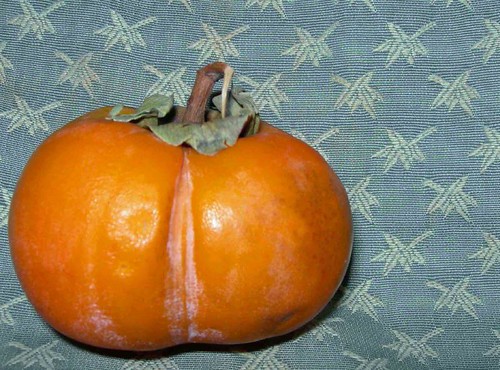 The first, 단감 (dan gam), is the cheapest, as it is the persimmon that is picked and eaten fresh. It has firm flesh like that of an apple, but not so juicy. The flavour is mild and not overly sweet.
The first, 단감 (dan gam), is the cheapest, as it is the persimmon that is picked and eaten fresh. It has firm flesh like that of an apple, but not so juicy. The flavour is mild and not overly sweet.  The next is 홍시 (hong si), which are red persimmons that are carefully ripened, either on the tree or (more commonly) in a warm room under careful watch. These fruit are slimy and sweet inside, and due to the care taken in ripening them, are quite expensive. (Update: you can find a much better picture of 홍시 than this one at Delicious Biting.)
The next is 홍시 (hong si), which are red persimmons that are carefully ripened, either on the tree or (more commonly) in a warm room under careful watch. These fruit are slimy and sweet inside, and due to the care taken in ripening them, are quite expensive. (Update: you can find a much better picture of 홍시 than this one at Delicious Biting.)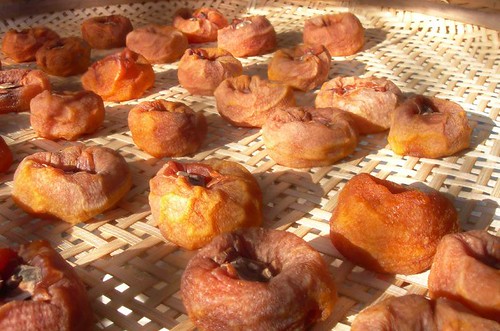 The third kind, 곶감 (kot gam), are persimmons that are peeled, strung, and dried. There are several stages of drying, some which are still very moist inside and should be kept in the freezer until eating, while others are fully dried and are very chewy. The flavour of the dried persimmons is not unlike dates or perhaps dried figs. Dried persimmons are also quite expensive, however, they are not too hard to
The third kind, 곶감 (kot gam), are persimmons that are peeled, strung, and dried. There are several stages of drying, some which are still very moist inside and should be kept in the freezer until eating, while others are fully dried and are very chewy. The flavour of the dried persimmons is not unlike dates or perhaps dried figs. Dried persimmons are also quite expensive, however, they are not too hard to 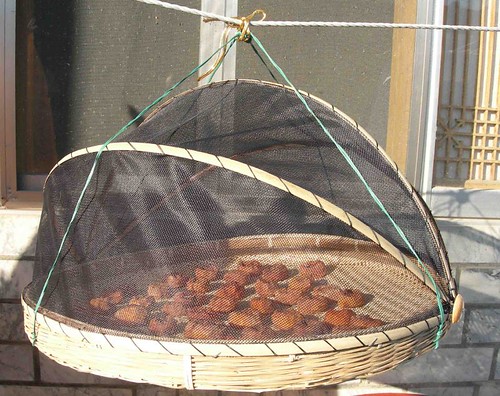 make if you have the time to peel and string them up on your balcony. I don’t think I’d recommend hanging out your own persimmons if you live in Seoul, though, considering the amount of soot and other chemicals in the air.
make if you have the time to peel and string them up on your balcony. I don’t think I’d recommend hanging out your own persimmons if you live in Seoul, though, considering the amount of soot and other chemicals in the air.I have asked several “country people” (family and coworkers) and some say that they each come from a different tree, while others say the last two are made with the same fruit. My personal preference is for the fresh or dried persimmons, as the texture of the ripe ones remind me too much of overripe bananas.
 Persimmons are an important element of my favorite Korean drink, 수정과 (Soo Jeong Gwa), a punch made by boiling water with cinnamon bark, ginger root and dried persimmons, then sweetened and served chilled (usually with a bit of slush floating at the top). This drink can be found in cans at most grocery or corner stores, and is served fresh at wedding buffets and at some saunas (찜질방). (See Delicious Biting and Scent of Green Bananas for pics and descriptions)
Persimmons are an important element of my favorite Korean drink, 수정과 (Soo Jeong Gwa), a punch made by boiling water with cinnamon bark, ginger root and dried persimmons, then sweetened and served chilled (usually with a bit of slush floating at the top). This drink can be found in cans at most grocery or corner stores, and is served fresh at wedding buffets and at some saunas (찜질방). (See Delicious Biting and Scent of Green Bananas for pics and descriptions) Other persimmon products include persimmon vinegar, and persimmon leaf tea. Persimmons also figure prominently in Korean traditional medicine, providing cleansing effects to the upper body, combating diarrhea, and removing phlegm from the lungs.
Persimmons also play an important role in a Korean tradition and stories. One book I have, Korean Folk and Fairy Tales, by Suzanne Crowder Han, has one of my favorite Korean folktales:
A poor farmer found a perfectly shaped and unusually large persimmon on his tree, and after showing to his friends, decided that such a persimmon was fit only for the king. He took it and presented it to the king, who was impressed by the peasant’s gift, and in return, gave him a lump of gold, as large as the persimmon. When the peasant returned with his rich reward, his neighbor eyed him with jealousy, and thought that he must also receive such a reward. He sold all his belongings to purchase the finest ox he could afford and headed off to the palace with visions of a piece of gold the size of an ox dancing in his head. When he presented his gift to the king, the king was also impressed with this gift, and asked his attendant what gifts he had received recently that he could bestow as a reward on his loyal subject. His servant brought out the persimmon and gave it to the selfish peasant, and sent him on his way with the thanks of the king for the fine ox.
I think I have come across a couple “westernized” stories like this in readers, one abut a beggar giving a piece of corn to the king (which is magically replaced by gold), and another involving an apple, but I can’t recall the details or the sources.
Another good Korean persimmon story is The Tiger and the Dried Persimmon.
Here’s a truncated version, courtesy of the Koreana Magazine:
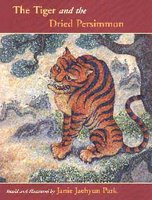 One day, a hungry tiger approached a farming village in search of food. As the tiger came upon a small house, he heard a mother inside the house screaming to her crying baby, "Stop! There's a tiger outside." The tiger was surprised that the mother knew he was there and expected the baby to stop crying. Surprisingly, the baby continued to cry. Then the mother said: "Look, here's a dried persimmon." And the baby stopped crying immediately. The tiger became frightened and ran away because he thought he came across something that was more powerful than himself.
One day, a hungry tiger approached a farming village in search of food. As the tiger came upon a small house, he heard a mother inside the house screaming to her crying baby, "Stop! There's a tiger outside." The tiger was surprised that the mother knew he was there and expected the baby to stop crying. Surprisingly, the baby continued to cry. Then the mother said: "Look, here's a dried persimmon." And the baby stopped crying immediately. The tiger became frightened and ran away because he thought he came across something that was more powerful than himself.If you haven’t already come to Korea in the fall and tried the persimmons, by all means, do. It will enhance your life!


1 Comments:
My wife must have a lot of patience to put up with my attempting to trick her with the persimmon/tomato confusion every fall. I haven't quite been able to convince her I really do think they are tomatoes.
Yesterday I was playin gwith little Alex with the TV on to a Skylife Kids Audio channel and we heard the 'dried persimmon' story.
댓글 쓰기
<< Home